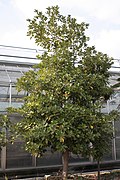- Makko powder, top left
- Flowers
- As a street tree in South Korea
- Sapling at the Chengdu Botanical Garden
- Hasaki no O-tabu
- As an object of veneration, Japan
| Machilus thunbergii | |
|---|---|
 | |
| In Hiroshima Castle | |
 | |
| Close up of leaves | |
| Scientific classification | |
| Kingdom: | Plantae |
| Clade: | Tracheophytes |
| Clade: | Angiosperms |
| Clade: | Magnoliids |
| Order: | Laurales |
| Family: | Lauraceae |
| Genus: | Machilus |
| Species: | M. thunbergii |
| Binomial name | |
| Machilus thunbergii | |
| Synonyms [2] | |
List
| |
Machilus thunbergii (syn. Persea thunbergii), the Japanese bay tree, red machilus, or tabunoki, is a widespread species of flowering plant in the family Lauraceae. [3] It is native to Vietnam, Taiwan, southeast and north-central China, the Korean Peninsula, and Japan. [2] A sturdy evergreen tree, usually 10–15 m (30–50 ft) tall, and reaching 20 m (70 ft), it is used for timber, and as a street tree. [4] Its bark is the source of makko, a powder used to make a mosquito‑repelling incense. [5] It prefers coastal areas, and can handle saline soil. [3]






